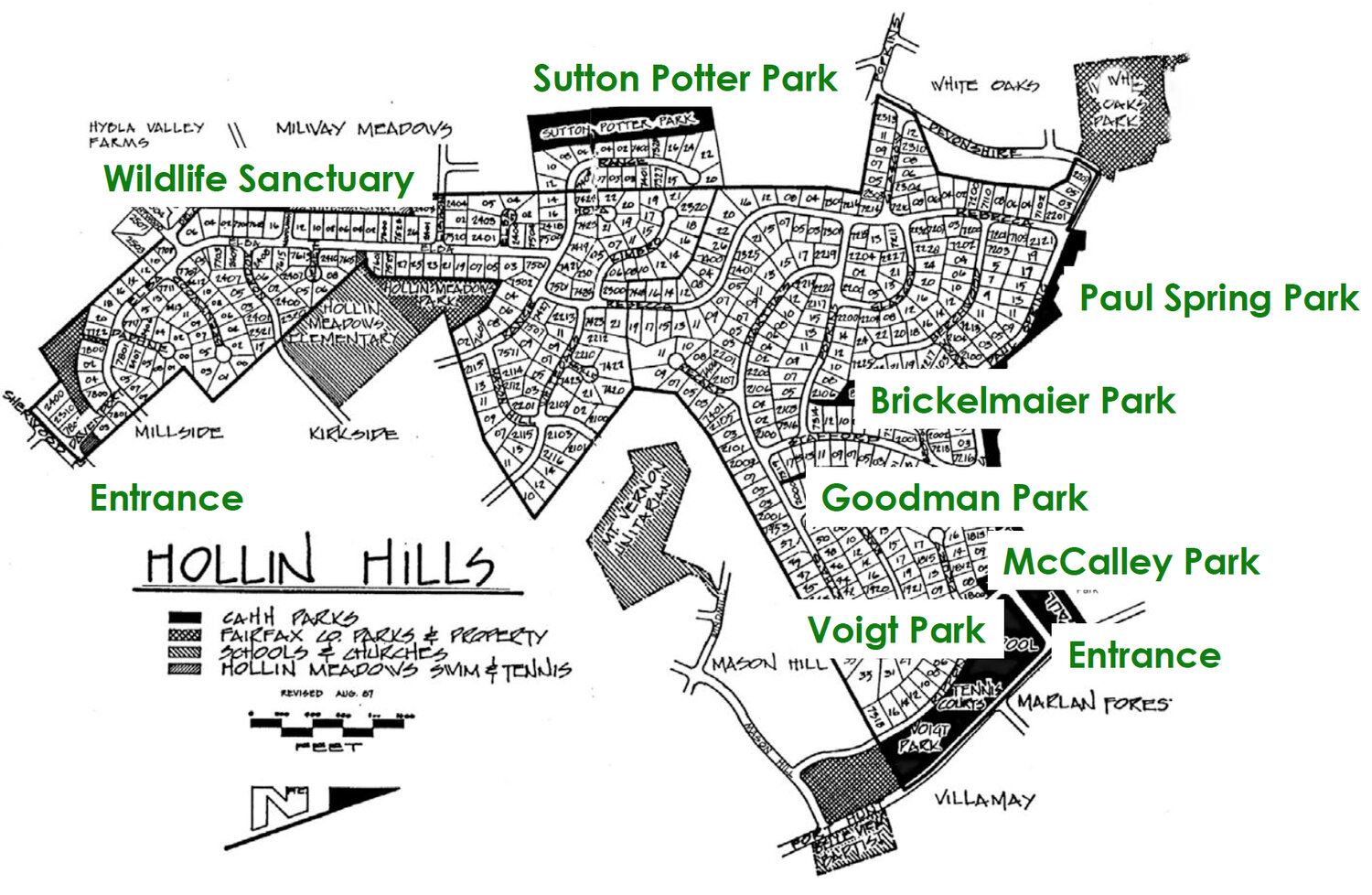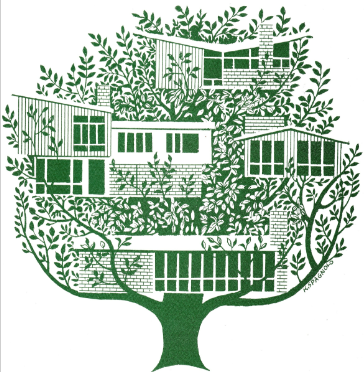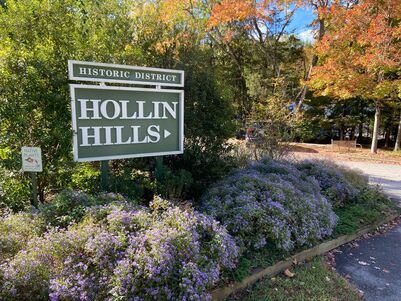Parks & Recreation in Hollin Hills

One of the most distinctive features of Hollin Hills is the 30 acres of parkland that weave through it, providing beauty and recreational areas for residents, a gentle setting for the architecture, and a rich, diverse habitat for animal life, from deer and foxes to migratory birds.
The parks were originally the brainchild of developer Robert Davenport. In 1954, shortly after establishing the community, Davenport set aside 13 acres of land to be used as parks, which would be owned and managed by the Civic Association of Hollin Hills. The parks were named in a community contest.
That parkland has grown to over 30 acres as the community has expanded, and now provides a varied setting for community get-togethers (such as the annual 4th of July picnic), concerts, play areas for kids, hiking, dog-walking and other activities.
As part of the community's ecosystem, these largely forested areas function as important wildlife habitats, improve air quality, contribute to stormwater management, reduce ambient summertime temperatures, and provide a wealth of material for nature study.
The parks (with the exception of McCalley Park) are owned by the Civic Association of Hollin Hills, which maintains them for the use of the community through its Parks Committee and park wardens. As stewards of the parks, the CAHH works to keep the parks healthy and safe, conserve wildlife habitats and native plants, protect water quality and address drainage and erosion issues.
The CAHH Parks Committee monitors the conditions of the parks, organizes periodic “clean-up parties” (see Events calendar) to remove invasive plants and do other maintenance work, and contracts out work for larger projects such as removing dead or dying trees, repairing play equipment, and mowing grassy areas.
The CAHH Parks Committee administers the Civic Association's annual parks budget, which is $38,800 for 2024—funding which comes from Civic Association membership dues, parks donations and grants from organizations such as the Friends of Hollin Hills.
While the CAHH Parks Committee takes the lead role, community support and participation are crucial to maintain the parks. Please consider joining one of the many clean-up parties held throughout the year, volunteering to become a park warden, and/or making a financial donation to the parks.
| The EntrancesThe Parks Committee also looks after the entrances to Hollin Hills at Fort Hunt Road and Sherwood Hall Lane. With a grant from the Audubon Society, the Committee in 2021 replaced the non-native plants at the Fort Hunt entrance with an “oasis” of native species that provides berries, seeds, nectar, and pollen for insects and birds; food for butterfly and moth larvae; and nesting sites and shelter for birds and other wildlife. Details about the plants used are available in this handout -- HH_Entry_handout.pdf The Sherwood Hall Lane entrance is also getting a makeover, and is being replanted with native species in 2024, thanks to a generous donation from Jim Wheeler and Sally Watkins. |
Voigt ParkVoigt Memorial Park is a set of three properties totaling 9.77 acres with an open rectangular, 3.41-acre park located between Fort Hunt Road and Rippon Road at the eastern edge of Hollin Hills, abutting the swim club. It’s the site of the annual 4th of July picnic and other community get-togethers, and boasts a swing set, picnic tables and other play equipment. In 2021, volunteers built a bocce court in the south end of the park, along Rippon Road. In 2024, volunteers planted a willow dome. The main entrance to Voigt Park is at the corner of Rippon Road and Paul Spring Road, but the park can also be accessed from Rippon Road further to the south. The park is named after landscape architect, Lou Bernard "Barney" Voigt, who was instrumental in the overall Hollin Hills site plan and responsible for many of the individual property landscape plans. Sadly, Voigt’s work was cut short in 1953 by his untimely death at 37. The following year, the existing park — known as Rippon Park — was renamed Voigt Memorial Park, in recognition of his innovative work. Voigt Park is located in a state and locally regulated Resource Protection Area, which is a part of the Chesapeake Bay Preservation program. Voigt Park has endured periodic flooding in recent years, and has benefited from frequent volunteer work parties, as well as repairs to park amenities funded by the Civic Association and Friends of Hollin Hills. | No pictures to show |
Paul Spring ParkPaul Spring Park is a 6.38-acre park that runs along the north side of Paul Spring Road. Located at the northern end of Hollin Hills, the park extends from Fort Hunt Road to Rebecca Drive, serving as a nature walk and jogging path along the creek. Several benches are located through the park, which is level and popular with dog-walkers. It can be entered at multiple points along Paul Spring Road and only a few yards away from Fairfax County's White Oaks Park. |
Goodman Park & TrailCharles Goodman Park is named after the neighborhood's master architect and planner. The sloping, narrow 3.20 acre park runs roughly north-south from Paul Spring Road to Martha's Road, and can be accessed at either end. (The park is currently closed as erosion and replanting issues are addressed.) One of the original areas designed as a park and deeded to the Civic Association in 1956, the park was initially known as East Stafford Park; it was renamed in 1992. A stormwater management project was launched in Goodman Park in 2021 to address the erosion problem that had caused deep chasms in the park. Construction ended in 2022, and the park has been replanted with thousands of native species, replacing the English ivy and other invasive species that had overrun the park. The park and trail directly border 28 home properties and is similar to Brickelmaier Park in that a riparian zone exists along its stream and it is mostly forested land following the Paul Spring Branch stream with a riparian corridor. |
Brickelmaier Park & TrailBrickelmaier Park runs north-south from Paul Spring Road to Popkins Lane, and can be accessed at either end. At just over three acres (3.10 acres), the park originally was known as West Stafford Park, but was renamed in 1978 in honor of George Brickelmaier, an original resident of Hollin Hills who worked with developer Robert Davenport. The gently sloping park has a bench about midway between the two entrances. A stormwater management project was launched in Brickelmaier Park in 2021 to address erosion problems in the park. Construction ended in 2022, and the park has been replanted with thousands of native species, replacing the English ivy and other invasive species that had overrun the park. A new trail, designed by Hollin Hills resident Robert Fina, has also been established. The park and trail borders 20 properties along Beechwood Road, Stafford Road, Bedford Lane, and Pickwick Lane. The park is mostly forested land that followed the natural watercourse of the Paul Spring Branch stream with a riparian corridor which buffers the stream. The park is within a designated RPA since 2003. |
Sutton Potter ParkSutton Potter Park is a narrow, sloping 5.37-acre park along with a much smaller 0.29 acre access tract (aka, the dogleg) at the western edge of Hollin Hills, and can be entered via a path in the 7400 block of Range Road. The park abuts the steep sledding hill (cheerfully known as “Suicide Hill”) at Popkins Farm. Acquired in 1966 to serve as a buffer between Hollin Hills and the Mount Vernon Square Townhouses, the park was initially called Popkins Farm Park, but was later re-named for Hollin Hills resident W. Sutton Potter. An attorney, member of the Board of Governors of the Federal Reserve, and husband of Mary-Carroll Potter, Sutton Potter had been instrumental in acquiring the land. He passed away in 1976, at the age of 46. The park had become overrun with invasive species, but recently underwent a multi-year cleanup under the direction of then-warden Mary Ellen Gilman, who managed the removal of two acres of invasive honeysuckle bush shrubs and restored the park to beauty. The homes along this block (officially designated in county records as Hollin Meadows) are a semi-exclave to Hollin Hills; its homeowners and residents are allowed to join and become members of the CAHH. This park is located outside the historic district and HOD. |
No pictures to show | McCalley Park
McCalley Park — named after Charles R. “Mac” McCalley, the construction foreman of Hollin Hills from 1949 to 1971— is a small (0.35 acres) park at the southwest corner of Paul Spring Road and Rippon Road. It was once a private residence, but the house was razed due to repeated flooding, and the land was bought by Fairfax County in 1990. It’s the only Hollin Hills park not owned by the Civic Association, but the Civic Association still manages the park. Two benches have been installed in the park by Friends of Hollin Hills, and carolers meet here at Christmas for a community sing. |
The Wildlife SanctuaryThe Wildlife Sanctuary, located along Delafield Place and west of Elba Road, was acquired through a land trade with Fairfax County in 1976. This level, 2.3-acre tract was subdivided for development in the 1960s, but never improved, possibly because of its environmental sensitivity. Not far from the Wildlife Sanctuary is a different, 2.42-acre parcel of land, located to the southwest of the 7800 block of Elba Road. It was originally included in the plats of Hollin Hills and dedicated for public use by Robert Davenport. However, this parcel was purchased by the Fairfax County Park Authority in 1999 and is no longer owned by the Civic Association of Hollin Hills. |

